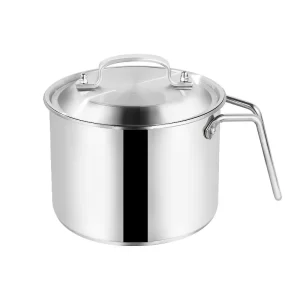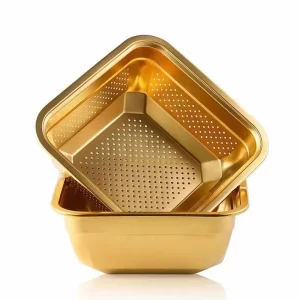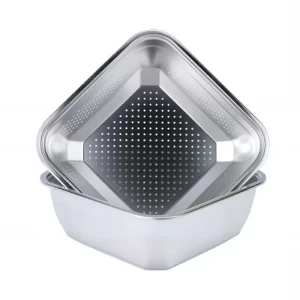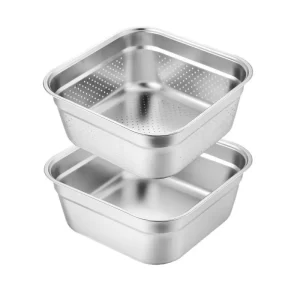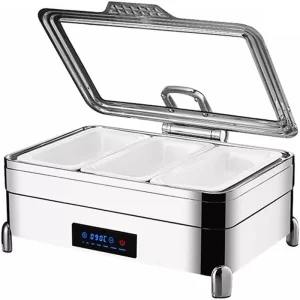Introduction
Les bouilloires sont des appareils omniprésents et indispensables dans les foyers et les restaurants modernes. Cependant, les consommateurs sont généralement confrontés à un dilemme lorsqu'ils choisissent une bouilloire : doivent-ils utiliser une bouilloire en verre ou une bouilloire en acier inoxydable est-elle plus saine ? Les préoccupations en matière de santé augmentant en même temps que le niveau de vie, les consommateurs s'intéressent de plus en plus à la sécurité, à la durabilité et à l'expérience globale de l'utilisateur des appareils de chauffage de l'eau. Cet article présente les différences entre les bouilloires en verre et les bouilloires en acier inoxydable sous différents aspects, afin que vous puissiez faire un meilleur choix.
Avantages et limites des bouilloires en verre
En tant que matériau traditionnel et pur, le plus grand avantage des bouilloires en verre est qu'elles sont transparentes - les clients peuvent voir directement le processus d'ébullition et la qualité de l'eau, ce qui plaît aux clients qui accordent de l'importance à la beauté visuelle et à la propreté. Le verre ne contient pas de pièces métalliques, n'est pas réactif à l'eau et ne dégage pas d'odeur ; il est donc souvent considéré comme "naturel et sûr".
Cependant, la fragilité du verre est son plus grand inconvénient. Dans la pratique, même de légers chocs ou changements thermiques peuvent provoquer des éclats, en particulier sur le lieu de travail ou dans les maisons familiales avec des enfants, ce qui ne peut être ignoré. En outre, les bouilloires en verre ne se réchauffent pas très efficacement et se refroidissent plus rapidement, ce qui n'est pas souhaitable lorsque l'on a besoin d'eau chaude pendant une longue période. D'un point de vue purement énergétique, les bouilloires en verre consomment généralement plus d'énergie pour compenser leur non-conductivité thermique, ce qui rend la consommation d'énergie indirecte.
Propriétés des matériaux et avantages pour la santé Bouilloires en acier inoxydable
Comparées au verre, les marmites en acier inoxydable se distinguent par leur solidité, leur durabilité et leur sécurité. L'acier inoxydable de haute qualité offre une meilleure résistance à la corrosion et à l'oxydation, empêchant la lixiviation de produits chimiques nocifs, même en cas d'exposition prolongée à une chaleur et une humidité intenses. L'acier inoxydable de qualité alimentaire répond aux normes internationales de sécurité et est largement utilisé dans la vaisselle, les ustensiles de cuisine et les appareils médicaux, ce qui prouve encore sa sécurité et sa fiabilité.
Les bouilloires en acier inoxydable sont également avantageuses en termes d'efficacité de chauffage. Le métal conduit la chaleur plus efficacement que le verre, ce qui permet de chauffer l'eau plus rapidement et d'économiser du temps et de l'énergie. Cette efficacité s'avère très pratique pour ceux qui ont une vie très active. Par exemple, une bouilloire électrique en acier inoxydable de 1,5 litre met 4 à 5 minutes pour faire bouillir l'eau, alors qu'une bouilloire en verre de même capacité met 6 à 7 minutes. Cela permet non seulement de gagner du temps, mais aussi de réduire les coûts d'électricité à long terme.
Comparaison de l'expérience utilisateur et du nettoyage et de l'entretien
Une bouilloire en acier inoxydable est le meilleur choix en termes d'expérience utilisateur pour la plupart des foyers et des entreprises. La solidité de l'acier inoxydable réduit le risque de bris de verre. Même dans des environnements très sollicités comme les restaurants, les bouilloires en acier inoxydable conservent des performances constantes et une durée de vie plus longue.
En ce qui concerne le nettoyage, la finition lisse de l'acier inoxydable résiste aux taches et au calcaire. Pour le nettoyage quotidien, de l'eau chaude additionnée d'un peu de vinaigre ou d'acide citrique suffit à éliminer le calcaire, sans aucun problème. Si les bouilloires en verre permettent d'inspecter facilement l'accumulation de calcaire par visibilité, leur fragilité exige une attention particulière lors du nettoyage afin d'éviter les dommages causés par les rayures ou une utilisation brutale. Les familles soucieuses de praticité et de commodité préféreront certainement l'acier inoxydable.
Préoccupations en matière d'environnement et de sécurité
Du point de vue de la sécurité, le plus grand risque des bouilloires en verre est de se briser, ce qui peut entraîner des coupures ou des brûlures. Une bouilloire en acier inoxydable, en revanche, élimine pratiquement ce risque, ce qui rend l'environnement plus sûr et plus fiable. Dans les restaurants, les hôtels ou les lieux publics, l'acier inoxydable est la seule option qui puisse être utilisée.
Du point de vue de l'environnement, un produit en acier inoxydable est recyclable et peut être recyclé et réutilisé afin de réduire les déchets. Le verre est également recyclable, mais il consomme plus d'énergie lors de son transport et de sa transformation, et ne bénéficie pas de la réutilisation dans le monde entier comme l'acier inoxydable. Ainsi, du point de vue de la durabilité, une bouilloire en acier inoxydable est un choix plus écologique en ce qui concerne les concepts verts et respectueux de l'environnement.
Comparaison des prix et des valeurs
Le coût est généralement un facteur décisif dans le choix d'une bouilloire. Les bouilloires en verre sont généralement moins chères et semblent plus économiques. Toutefois, si l'on considère les coûts à long terme, les bouilloires en verre s'abîment facilement et ne durent pas longtemps, ce qui nécessite des remplacements fréquents. Le coût initial de l'achat d'une bouilloire en acier inoxydable est certes plus élevé, mais sa durabilité et sa fiabilité permettent de réduire considérablement les coûts de remplacement à long terme. Sur la base d'une durée de vie de cinq ans, une bouilloire en acier inoxydable de haute qualité peut être remplacée une fois, tandis qu'une bouilloire en verre doit être remplacée trois ou quatre fois, ce qui augmente les dépenses globales. D'un point de vue économique, l'acier inoxydable est donc le choix le plus avantageux.
Conclusion
Après avoir examiné en détail différents facteurs tels que la durabilité, la santé, la sécurité, la consommation d'énergie et le respect de l'environnement, on constate que, malgré certains atouts des bouilloires en verre sur le plan de l'esthétique et des propriétés intrinsèques, les bouilloires en acier inoxydable sont, dans l'ensemble, mieux adaptées aux besoins réels des ménages et des secteurs de la restauration. Elles fournissent non seulement de l'eau potable, mais aussi de l'endurance et de l'efficacité énergétique, et constituent donc le choix idéal pour ceux qui ont besoin d'une qualité de vie. En d'autres termes, si l'on demande "une bouilloire en verre ou une bouilloire en acier inoxydable" et laquelle est la plus saine, la réponse est sans aucun doute la seconde.
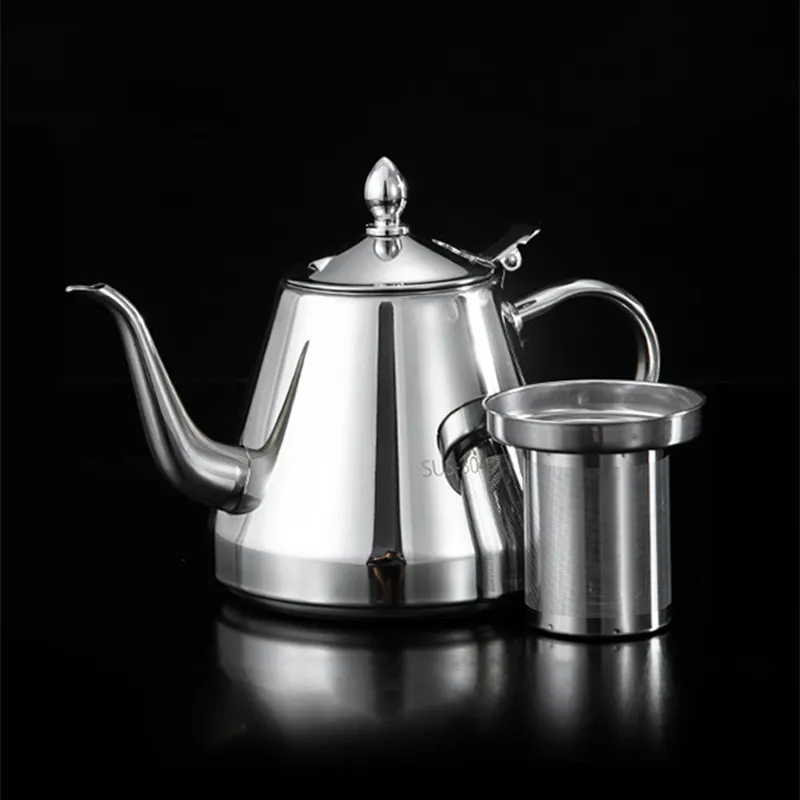
À propos de Yongyu
Yongyu est l'un des principaux fabricants d'ustensiles de cuisine et grossistes en fournitures de restauration, qui se consacre à la fourniture d'ustensiles de cuisine en acier inoxydable et de fournitures de restauration de haute qualité à des clients du monde entier. Nous proposons des services en gros et personnalisés, avec une gamme de produits allant des bouilloires en acier inoxydable à la vaisselle et aux ustensiles de cuisine, largement utilisés dans les foyers, les restaurants et les hôtels. Yongyu applique un contrôle de qualité rigoureux et une conception créative, non seulement pour la performance, mais aussi pour la protection de la santé et de l'environnement. Si vous avez besoin d'un fournisseur fiable, Yongyu est un bon choix.
Questions les plus fréquemment posées (FAQ)
1. Qu'est-ce qui est le plus facile à nettoyer, une bouilloire en acier inoxydable ou en verre ?
Les bouilloires en verre sont transparentes et permettent de voir les dépôts de calcaire, mais elles sont fragiles et doivent être manipulées avec précaution lors du nettoyage. Les bouilloires en acier inoxydable sont résistantes aux taches et faciles à nettoyer ; il suffit de les nettoyer au vinaigre ou à l'acide citrique pour que le tartre disparaisse.
2. Une bouilloire en acier inoxydable rouille-t-elle ?
L'acier inoxydable de qualité alimentaire est très résistant à la corrosion et ne rouille pas dans des conditions normales d'utilisation et de nettoyage. Évitez de stocker l'eau pendant de longues périodes afin de la faire durer plus longtemps.
3. L'eau bouillante dans une bouilloire en verre libère-t-elle des substances chimiques nocives ?
Le verre ne produit pas de substances chimiques nocives, mais il se brise. L'acier inoxydable, en revanche, est plus stable du point de vue de la santé et de la sécurité.
4.Quelle est la bouilloire idéale pour les entreprises ?
Dans les restaurants, les cafés et les hôtels, la bouilloire en acier inoxydable est idéale en raison de sa solidité, de sa sécurité et de son efficacité énergétique, qui permettent une utilisation fréquente.
Contactez Yongyu pour obtenir la meilleure solution !

